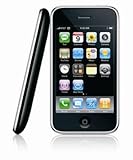Software

iPod Capabilities include playing:
Ipod
1. Mp3 audio file formats.

iPhone 3GS 16 GB Black Unlocked Features
- Improved performance and updated 3D graphics deliver an incredible gaming experience, too
- In fact, everything you do on iPhone 3GS is up to 2x faster and more responsive than iPhone 3G
- Trim your footage by adjusting start and end points
Available Stores
|
2. Wav audio file formats.
3.M4A / Aac Lc audio file formats.
4. Protected Aac audio file formats.
5. Aiff audio file formats.
6. Audible audiobook audio file formats and
7. Apple Lossless audio file formats.
iPod capabilities of the 5th generation version plays .m4v and .mp4 Mpeg-4 video file formats.
Microsoft Windows version of iTunes can transcode quarterly non copy-protected Wma files to an
iPod supported format. Wma files with copy protection cannot be played in iTunes or be copied to an iPod.
What I do not like about the iPod is the inability to play some other formats, in particular the Ogg Vorbis and Flac formats. Midi files cannot be played on iPods as well, but can be converted into a compatible audio file format by selecting the "advanced" menu on iTunes.
Apple has designed the iPod to work with the iTunes media library software, which lets you carry on your music libraries on your computer and on your iPod. Itunes can automatically synchronize your iPod with exact playlists or with the entire contents of a music library each time you associate your iPod to a host computer.
You can also set a rating (out of 5 stars) on any song, and can synchronize that information to an iTunes music library. Itunes lacks the ability to exchange songs from iPod to computer because of legality issues.
However, several third-party programs exist that supply music synchronization facilities similar to iTunes, but also offer the ability to copy music from iPod back to your host computer. Preeminent examples include vPod and the Ml iPod plugin for Winamp.
iTunes Music Store
The iTunes Music Store (iTms) is an online music store run by Apple and accessed via iTunes. It was
introduced on 28 April, 2003 and sells private songs relatively for real and cheaply (e.g. 0.99 Usd,
0.99 Euro, 0.79 Gbp).
iPod's are the only transported music player that can play the purchased music, and this exclusiveness has
helped the store come to be the dominant online music service.
The purchased audio files use the Aac format with added encryption. The encryption is based on FairPlay Digital possession administration (Drm) system. Up to five authorized computers and an unlimited number of iPods can play the files.
Burning the files onto an audio Cd removes the Digital possession administration (Drm), at a cost of reduced
quality when re-compressed from one lossy format to another.
iPods cannot play music files encrypted with other rival Digital possession administration (Drm) technologies,
such as Microsoft's protected Wma or RealNetworks' Helix-Drm.
Hardware
iPod capabilities was to associate it to a user's computer to modernize songs and recharge its battery solely
through FireWire originally. It could also be expensed by connecting it to a small power adapter which are shipped for free with several of the first generation iPod's.
The now appropriate dock connector was not added until the 3rd generation in April 2003, allowing users
the choice of using FireWire or Usb to make data transfers, although the gadget could still not be
charged by Usb and the Usb cable was not included.
Most Pc's don't have FireWire ports so this move effectively opened the Windows market to iPod, although Usb only Windows users had to keep their FireWire cables to plug into the wall adapter.
The dock connector also made it potential to exchange data, sound, and power back and forth to iPod accesories, which created an explosive market of devices that has been highly profitable for third parties such as Belkin and Griffin. The resulting myriad of connecting devices is still one of iPod's greatest strengths over its competititors.
iPod capabilities of the 4th generation version could be expensed with Usb, and eventually Apple started shipping iPods with Usb cables instead of one's with FireWire. Many Macs shipped before 2004 had only Usb 1.1, which has a exchange speed of 11 Mbit/s, as opposed to FireWire's 400 and Usb 2.0's 480.
Although none of these for real transfers at these exact rates, Usb 1.1 is much slower than the other two, and for some Usb 1.1 may plainly be unusable for transferring music collections to fill a 40 Gb iPod. Later introductions has continued to lessen iPod's trust on FireWire.
iPod Shuffle, released in January 2005, plugs directly into a Usb port, without a dock connector and has no Firewire support. The iPod Nano, released in September 2005, uses a dock connector that allows a FireWire cable to be plugged in to payment the device, but not to exchange data. With the 5th generation iPod, Apple dropped all sustain for data exchange over Firewire to any model iPod.
Like the Nano, the 5th generation iPod's dock connector will accept a FireWire cable and can draw power from it, but only the Usb connection, not the one with FireWire, will sustain data exchange - a message stating this appears on the iPod screen.
This has drawn some comment from the Mac community, since FireWire has been a appropriate feature on Apple Macs for many years, while Usb 2.0 sustain was only added in October 2003.
The first three generations of iPod used two Arm 7Tdmi-derived Cpus running at 90 Mhz, while later models have variable speed chips which run at a peak of 80 Mhz to save battery life.
The iPod use 1.8 inch (46 mm) Ata hard drives (with a possession connector) made by Toshiba and the iPod Mini uses one-inch contract Flash microdrive hard drives made by Hitachi. It has a 32 MiB flash Rom chip which contains a bootloader, a program that tells the gadget to load the operating ideas from other medium (in this case, the hard drive).
All iPods, except for the 60 Gb 5th generation version, has 32 MiB of Ram, a part of which holds the Os loaded from the firmware and the vast majority of which serves to cache songs loaded from the hard drive.
For example, an iPod could spin the hard disk up once and copy about 30 MiB of upcoming songs on a playlist into Ram, thus recovery power by not having the drive spin up for each song. (The 60 Gb fifth-generation iPod holds 64 MiB of Ram, to supplementary extend battery life.)
iPod was originally introduced with a black and white display but no current model uses one. iPod Photo (an addition to the functionality of the 4th generation iPod released in late 2004) introduced a color screen, while iPod shuffle (released January 2005) has no screen at all.
When iPod Mini was supplanted with iPod Nano it received a colour screen (and photo capabilty) and starting with the 5th generation all full size iPods have color screens and photo capability.
Here is a link in reference to this record iPod Capabilities
iPod Capabilities
0 comments:
Post a Comment